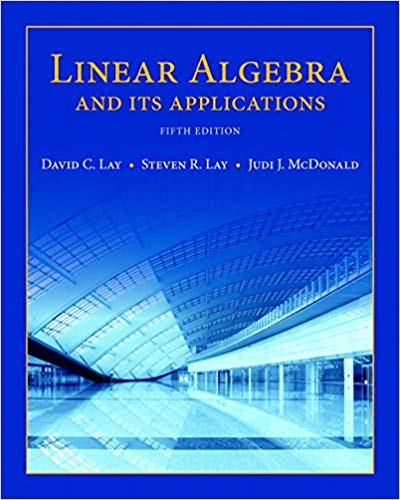
Linear Algebra and Its Applications, 5th Edition
Authors: David C. Lay, Steven R. Lay, Judi J. McDonald
ISBN-13: 978-0321982384
We have solutions for your book!
See our solution for Question 17E from Chapter 3.SE from Lay's Linear Algebra and Its Applications, 5th Edition.
Problem 17E
Chapter:
Problem:
0
Step-by-Step Solution
Given Information
We are given with 3 matrices \[ A=\left[\begin{array}{lllll}{a} & {b} & {b} & {\dots} & {b} \\ {b} & {a} & {b} & {\dots} & {b} \\ {b} & {b} & {a} & {\dots} & {b} \\ {\vdots} & {\vdots} & {\vdots} & {\ddots} & {\vdots} \\ {b} & {b} & {b} & {\cdots} & {a}\end{array}\right], B=\left[\begin{array}{ccccc}{a-b} & {b} & {b} & {\dots} & {b} \\ {0} & {a} & {b} & {\dots} & {b} \\ {0} & {b} & {a} & {\dots} & {b} \\ {\vdots} & {\vdots} & {\vdots} & {\ddots} & {\vdots} \\ {0} & {b} & {b} & {\cdots} & {a}\end{array}\right], \text { and } C=\left[\begin{array}{ccccc}{b} & {b} & {b} & {\dots} & {b} \\ {b} & {a} & {b} & {\dots} & {b} \\ {b} & {b} & {a} & {\dots} & {b} \\ {\vdots} & {\vdots} & {\vdots} & {\ddots} & {\vdots} \\ {b} & {b} & {b} & {\cdots} & {a}\end{array}\right] \] Using induction, we have to confirm that \[ \operatorname{det} A=(a-b)^{n-1}(a+(n-1) b) \]
Step-1:
For $n=2$ \[ \begin{aligned} \operatorname{det} B &=\left|\begin{array}{cc}{a-b} & {b} \\ {0} & {a}\end{array}\right| \\ &=a(a-b) \\ &=a^{2}-a b \end{aligned} \] \[ \begin{array}{l}{\operatorname{det} C=\left|\begin{array}{ll}{b} & {b} \\ {b} & {a}\end{array}\right|} \\ {=a b-b^{2}}\end{array} \] Hence, \[ \begin{aligned} \operatorname{det} A &=\operatorname{det} B+\operatorname{det} C \\ &=a(a-b)+a b-b^{2} \\ &=a^{2}-b^{2} \\ &=(a-b)(a+b) \\=&(a-b)^{2-1}(a+(2-1) b) \end{aligned} \] Therefore, for $n=2$, \[\det A = = {(a - b)^{2 - 1}}(a + (2 - 1)b)\]
Step-2:
Let formula holds for $n=k-1$.
Determinant of B is: \[\begin{array}{l} \det B = (a - b)\left| {\begin{array}{*{20}{c}} a&b& \ldots &b\\ b&a& \ldots &b\\ \vdots & \vdots & \ddots & \vdots \\ b&b& \ldots &a \end{array}} \right|\\ = (a - b){(a - b)^{k - 2}}(a + (k - 2)b)\\ = (a - b){(a - b)^{k - 2}}(a + (k - 2)b)\\ = {(a - b)^{k - 1}}(a + (k - 2)b) \end{array}\] Determinant of C is: \[\begin{array}{l} \det C = \left| {\left| {\begin{array}{*{20}{c}} b&b& \ldots &b\\ 0&{a - b}& \ldots &0\\ \vdots & \vdots & \ddots & \vdots \\ 0&0& \ldots &{a - b} \end{array}} \right|} \right|\\ = b{(a - b)^{k - 1}} \end{array}\] So, \[ \begin{aligned} \operatorname{det} A &=\operatorname{det} B+\operatorname{det} C \\ &=(a-b)^{k-1}(a+(k-2) b)+b(a-b)^{k-1} \\ &=(a-b)^{k-1}(a+(k-2) b+b) \\ &=(a-b)^{k-1}(a+(k-1) b) \end{aligned} \] The above result is True for $n=k$. Hence by induction,
\[ \operatorname{det} A=(a-b)^{n-1}(a+(n-1) b) \]
We are given with 3 matrices \[ A=\left[\begin{array}{lllll}{a} & {b} & {b} & {\dots} & {b} \\ {b} & {a} & {b} & {\dots} & {b} \\ {b} & {b} & {a} & {\dots} & {b} \\ {\vdots} & {\vdots} & {\vdots} & {\ddots} & {\vdots} \\ {b} & {b} & {b} & {\cdots} & {a}\end{array}\right], B=\left[\begin{array}{ccccc}{a-b} & {b} & {b} & {\dots} & {b} \\ {0} & {a} & {b} & {\dots} & {b} \\ {0} & {b} & {a} & {\dots} & {b} \\ {\vdots} & {\vdots} & {\vdots} & {\ddots} & {\vdots} \\ {0} & {b} & {b} & {\cdots} & {a}\end{array}\right], \text { and } C=\left[\begin{array}{ccccc}{b} & {b} & {b} & {\dots} & {b} \\ {b} & {a} & {b} & {\dots} & {b} \\ {b} & {b} & {a} & {\dots} & {b} \\ {\vdots} & {\vdots} & {\vdots} & {\ddots} & {\vdots} \\ {b} & {b} & {b} & {\cdots} & {a}\end{array}\right] \] Using induction, we have to confirm that \[ \operatorname{det} A=(a-b)^{n-1}(a+(n-1) b) \]
Step-1:
For $n=2$ \[ \begin{aligned} \operatorname{det} B &=\left|\begin{array}{cc}{a-b} & {b} \\ {0} & {a}\end{array}\right| \\ &=a(a-b) \\ &=a^{2}-a b \end{aligned} \] \[ \begin{array}{l}{\operatorname{det} C=\left|\begin{array}{ll}{b} & {b} \\ {b} & {a}\end{array}\right|} \\ {=a b-b^{2}}\end{array} \] Hence, \[ \begin{aligned} \operatorname{det} A &=\operatorname{det} B+\operatorname{det} C \\ &=a(a-b)+a b-b^{2} \\ &=a^{2}-b^{2} \\ &=(a-b)(a+b) \\=&(a-b)^{2-1}(a+(2-1) b) \end{aligned} \] Therefore, for $n=2$, \[\det A = = {(a - b)^{2 - 1}}(a + (2 - 1)b)\]
Step-2:
Let formula holds for $n=k-1$.
Determinant of B is: \[\begin{array}{l} \det B = (a - b)\left| {\begin{array}{*{20}{c}} a&b& \ldots &b\\ b&a& \ldots &b\\ \vdots & \vdots & \ddots & \vdots \\ b&b& \ldots &a \end{array}} \right|\\ = (a - b){(a - b)^{k - 2}}(a + (k - 2)b)\\ = (a - b){(a - b)^{k - 2}}(a + (k - 2)b)\\ = {(a - b)^{k - 1}}(a + (k - 2)b) \end{array}\] Determinant of C is: \[\begin{array}{l} \det C = \left| {\left| {\begin{array}{*{20}{c}} b&b& \ldots &b\\ 0&{a - b}& \ldots &0\\ \vdots & \vdots & \ddots & \vdots \\ 0&0& \ldots &{a - b} \end{array}} \right|} \right|\\ = b{(a - b)^{k - 1}} \end{array}\] So, \[ \begin{aligned} \operatorname{det} A &=\operatorname{det} B+\operatorname{det} C \\ &=(a-b)^{k-1}(a+(k-2) b)+b(a-b)^{k-1} \\ &=(a-b)^{k-1}(a+(k-2) b+b) \\ &=(a-b)^{k-1}(a+(k-1) b) \end{aligned} \] The above result is True for $n=k$. Hence by induction,
\[ \operatorname{det} A=(a-b)^{n-1}(a+(n-1) b) \]